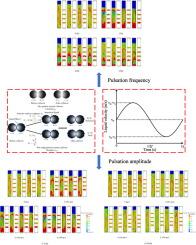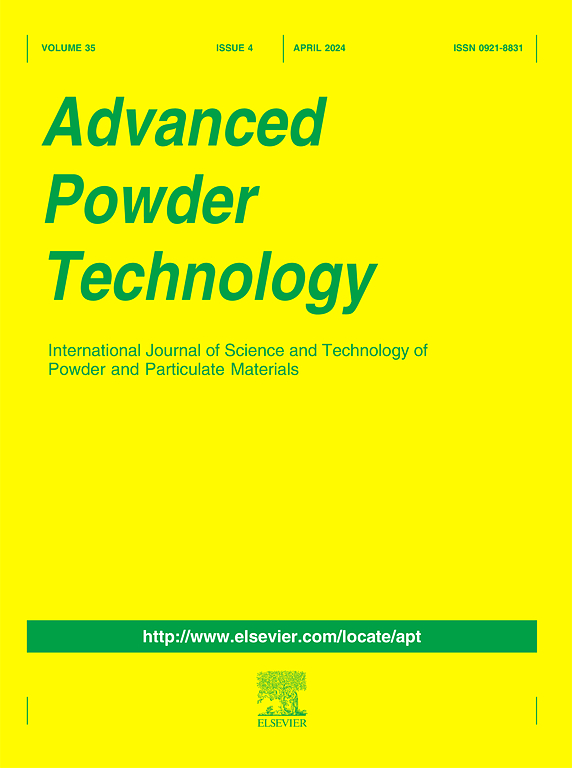3D CFD simulation of wet rough particles hydrodynamics in a pulsed fluidized bed using kinetic theory of rough spheres model
IF 4.2
2区 工程技术
Q2 ENGINEERING, CHEMICAL
引用次数: 0
Abstract
In the framework of kinetic theory of rough spheres (KTRS) model, a dynamic coefficient of restitution model is introduced to describe the collision behavior between wet rough particles in liquid. Based on the two-fluid model (TFM) combining kinetic theory of rough spheres, numerical simulations are conducted on the flow characteristic of rough particles and liquid in a pulsed fluidized bed. The simulation results are firstly validated against experimental data reported by Ehsani et al. Subsequently, the effects of pulsation flow on liquid–solid two-phase flow, particle collision and particle rotation behavior are studied. The results indicate that resonance fluidization occurs at a frequency of 1 Hz, which is approached to the natural frequency of the bed. Furthermore, the particle volume fraction increases with the pulsation amplitude at this frequency. Conversely, at a frequency of 36 Hz, the volume fraction exhibits the opposite trend with the pulsation amplitude. The interstitial fluid increases the dissipation of kinetic energy in particle collision, though its effect is much smaller than that caused by particle rotation.

利用粗糙球体模型动力学理论对脉冲流化床中的湿粗糙颗粒流体力学进行三维 CFD 模拟
在粗糙球体动力学理论(KTRS)模型的框架下,引入了动态恢复系数模型来描述湿粗糙颗粒在液体中的碰撞行为。基于结合粗糙球体动力学理论的双流体模型(TFM),对脉冲流化床中粗糙颗粒和液体的流动特性进行了数值模拟。模拟结果首先与 Ehsani 等人报告的实验数据进行了验证,随后研究了脉动流对液固两相流、颗粒碰撞和颗粒旋转行为的影响。结果表明,共振流化发生在频率为 1 Hz 时,接近床层的固有频率。此外,在该频率下,颗粒体积分数随脉动振幅的增加而增加。相反,在频率为 36 Hz 时,体积分数与脉动振幅呈相反趋势。间隙流体增加了颗粒碰撞动能的耗散,尽管其影响远远小于颗粒旋转造成的影响。
本文章由计算机程序翻译,如有差异,请以英文原文为准。
求助全文
约1分钟内获得全文
求助全文
来源期刊

Advanced Powder Technology
工程技术-工程:化工
CiteScore
9.50
自引率
7.70%
发文量
424
审稿时长
55 days
期刊介绍:
The aim of Advanced Powder Technology is to meet the demand for an international journal that integrates all aspects of science and technology research on powder and particulate materials. The journal fulfills this purpose by publishing original research papers, rapid communications, reviews, and translated articles by prominent researchers worldwide.
The editorial work of Advanced Powder Technology, which was founded as the International Journal of the Society of Powder Technology, Japan, is now shared by distinguished board members, who operate in a unique framework designed to respond to the increasing global demand for articles on not only powder and particles, but also on various materials produced from them.
Advanced Powder Technology covers various areas, but a discussion of powder and particles is required in articles. Topics include: Production of powder and particulate materials in gases and liquids(nanoparticles, fine ceramics, pharmaceuticals, novel functional materials, etc.); Aerosol and colloidal processing; Powder and particle characterization; Dynamics and phenomena; Calculation and simulation (CFD, DEM, Monte Carlo method, population balance, etc.); Measurement and control of powder processes; Particle modification; Comminution; Powder handling and operations (storage, transport, granulation, separation, fluidization, etc.)
 求助内容:
求助内容: 应助结果提醒方式:
应助结果提醒方式:


